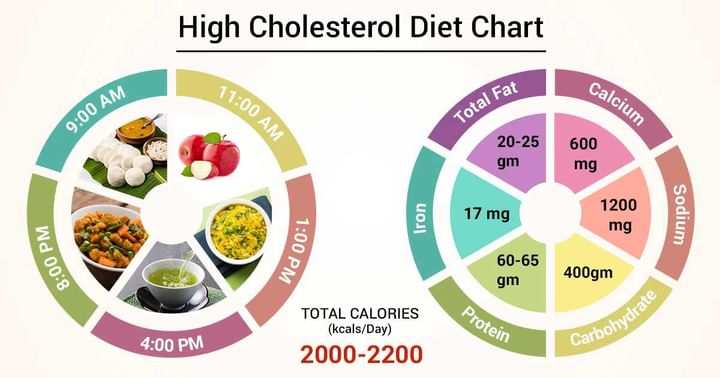Diet Chart For High Cholesterol
Last Updated: Jan 20, 2025
About
Some foods punch well above their weight in helping to reduce cholesterol levels – we call them the “Cholesterol busters”. Choosing a healthy diet, low in saturated fat is important in helping to keep your cholesterol low but you can reduce your cholesterol levels further by including these super six foods in your every day diet. Cholesterol is carried through the blood in molecules called lipoproteins. The two most commonly discussed in relation to heart health are low density lipoproteins (LDL) and high density lipoproteins (HDL). LDL (bad) deposit cholesterol inside your arteries. HDL (good) carry cholesterol to the liver to dispose of it or recycle it for future cell and hormone production, which makes it less likely that excess cholesterol in the blood will be dumped in the coronary arteries where it can build up.
Limit your intake of cholesterol from food to less than 300 mg per day. If your LDL is high, you have heart disease or you’re taking a cholesterol-lowering medication, it’s best to consume less than 200 mg of cholesterol per day. Foods high in cholesterol include liver and other organ meats, egg yolks and full-fat dairy products. Most of the fat in your diet should come from unsaturated fats (polyunsaturated and monounsaturated). Both polyunsaturated and monounsaturated fats may help lower your blood cholesterol level when you use them in place of saturated and trans fats in your diet. Keep total fat to less than 35 percent of total calories, or below 78 grams for 2,000 calories. Polyunsaturated fats are found in certain plant oils – safflower, sesame, soy, corn and sunflower-seed oils. Omega-3s, a type of polyunsaturated fat, are found in fatty fish like salmon, tuna and mackerel. Olive, canola, sunflower and peanut oils contain monounsaturated fats, and so do avocados.
Diet Chart
| Sunday | |
| Breakfast (8:00-8:30AM) | 4 Idly+ 1/2 cup sambhar+1 tsp coconut chutney+1 glass milk(toned)/ 1 cup tea |
| Mid-Meal (11:00-11:30AM) | 1 medium size apple |
| Lunch (2:00-2:30PM) | 1 cup rice+2 chapathi+fish (100gm) curry+cabbage and green peas sabji |
| Evening (4:00-4:30PM) | 1 cup boiled green gram sprouts with lemon+ 1 cup green tea |
| Dinner (8:00-8:30PM) | 3 chapathi+1/2 cup cauliflower sabji+1/2 cup vegetable salad |
| Monday | |
| Breakfast (8:00-8:30AM) | 1/2 cup Oats in 1 glass milk(toned) |
| Mid-Meal (11:00-11:30AM) | 1 medium size guava |
| Lunch (2:00-2:30PM) | 4 chapathi+1/2 cup chana dal+1/2 cup mooli methi sabji+1 glass butter milk |
| Evening (4:00-4:30PM) | 1 cup boiled bengalgram with lemon+ 1 cup green tea |
| Dinner (8:00-8:30PM) | 3 chapathi+ 1/2 cup bhindi sabji+ 1 cup vegetable salad |
| Tuesday | |
| Breakfast (8:00-8:30AM) | 3 dosa+1/2 cup sambhar+1tsp methi chutney+1 glass milk(toned)/ 1 cup tea |
| Mid-Meal (11:00-11:30AM) | 1 medium size pear |
| Lunch (2:00-2:30PM) | 1 cup rice+2 chapathi+aloo brinjal sabji+1/2 cup tomato dal+1 glass buttermilk |
| Evening (4:00-4:30PM) | 3 Cracker biscuits+ 1 cup tea/milk(toned) |
| Dinner (8:00-8:30PM) | 3 chapathi(multigrain-wheat;jowar;bajra)+lauki methi sabji+1/2 cup vegetable salad |
| Wednesday | |
| Breakfast (8:00-8:30AM) | 1 cup roasted oats upma with vegetables+1 glass milk/1 cup tea(toned) |
| Mid-Meal (11:00-11:30AM) | 1 banana |
| Lunch (2:00-2:30PM) | 4 chapathi+1/2 cup french beans curry+1/2 cup colocasia(arbi) sabji+ 1 glass buttermilk |
| Evening (4:00-4:30PM) | 1 bowl pop corn+1 cup tea/milk(toned) |
| Dinner (8:00-8:30PM) | 3 chapathi+1/2 cup palak sabji+1/2 cup vegetable salad |
| Thursday | |
| Breakfast (8:00-8:30AM) | 1 cup broken wheat upma with vegetables+1 glass milk/1 cup tea(toned) |
| Mid-Meal (11:00-11:30AM) | 100gm musk melon |
| Lunch (2:00-2:30PM) | 4 chapathi+1 portion(100gm) grilled/stewed fish+1/2 cup rajmah curry |
| Evening (4:00-4:30PM) | 1/2 cup Sweet potato salad+ 1 cup green tea |
| Dinner (8:00-8:30PM) | 3 chapathi+ 1/2 cup ridge gourd(thori) sabji+1/2 cup vegetable salad |
| Friday | |
| Breakfast (8:00-8:30AM) | 2 paratha(aloo/gobhi/methi) with 2 tsp green chutney+1 glass milk(toned)/ 1 cup tea |
| Mid-Meal (11:00-11:30AM) | 100gm pomegranate |
| Lunch (2:00-2:30PM) | 4 chapathi+1/2 cup cluster beans curry+1/2 cup capsicum sabji+ 1 glass buttermilk |
| Evening (4:00-4:30PM) | 1 small fistful (40 gm) of peanuts,almonds,walnuts+1 cup green tea |
| Dinner (8:00-8:30PM) | 3 chapathi+1/2 cup raw banana sabji+1/2 cup vegetable salad |
| Saturday | |
| Breakfast (8:00-8:30AM) | Vegetable sandwich with 4 whole wheat bread slices+cucumber,tomato, onion,spinach/lettuce+1 glass milk(toned)/ 1 cup tea |
| Mid-Meal (11:00-11:30AM) | 1 wedge(100gm) watermelon |
| Lunch (2:00-2:30PM) | 1 cup rice+2 chapathi+1/2 cup skin out chicken(100gm) curry+1/2 cup ivy gourd(parmal) sabji+1 glass buttermilk |
| Evening (4:00-4:30PM) | Avocado(50gm) whole wheat bread(3 slices) sandwich+ 1 cup green tea |
| Dinner (8:00-8:30PM) | 3 chapathi(multigrain-wheat;jowar;bajra)+1/2 cup tinda sabji+ 1/2 cup vegetable salad |
Do's And Dont's
Do's:
- Include foods high in HDL such as almonds, walnut, oats, flax seeds.
- Include fatty fish such as tuna, sardine, salmon, mackerel.
- Consume egg white and skin out chicken.
- Whole grains, legumes, vegetables and fruits is beneficial as they are rich in fibre.
- Include low fat milk products.
- Include 1 cup of green tea and physical activity in your daily routine.
- Include foods high in soluble fibre such as banana, oats, apple, guava, beans, avocados, berries, barley, quinoa, flax and chia seeds, figs, coconut, okra (ladies finger).
Don'ts:
- Avoid red meat, organ meats, shell fish as they are rich in cholesterol.
- Avoid consumption of foods made by reheated oil.
- Heavy oily foods, foods high in cream and cheese
- Avoid saturated fat such as palm oil, butter, margarine,ghee.
Food Items You Can Easily Consume
- Oats: Current nutrition guidelines recommend getting 20 to 35 grams of fiber a day, with at least 5 to 10 grams coming from soluble fiber.
- Barley and other whole grains. Like oats and oat bran, barley and other whole grains can help lower the risk of heart disease, mainly via the soluble fiber they deliver.
- Beans. Beans are especially rich in soluble fiber. They also take awhile for the body to digest, meaning you feel full for longer after a meal.
- Eggplant and okra. These two low-calorie vegetables are good sources of soluble fiber.
- Nuts: Eating almonds, walnuts, peanuts, and other nuts is good for the heart. Eating 2 ounces of nuts a day can slightly lower LDL, on the order of 5%.
- Vegetable oils. Using liquid vegetable oils such as canola, sunflower, safflower, and others in place of butter, lard, or shortening when cooking or at the table helps lower LDL.
- Soy. Eating soybeans and foods made from them, like tofu and soy milk, was once touted as a powerful way to lower cholesterol.
- Apples, grapes, strawberries, citrus fruits. These fruits are rich in pectin, a type of soluble fiber that lowers LDL.
References
- Woodhill JM, Palmer AJ, Leelarthaepin B, McGilchrist C, Blacket RB. Low fat, low cholesterol diet in secondary prevention of coronary heart disease. InDrugs, Lipid Metabolism, and Atherosclerosis 1978 (pp. 317-330). Springer, Boston, MA. [Cited 23 March 2020]. Available from:
- Rosenthal MB, Barnard RJ, Rose DP, Inkeles S, Hall J, Pritikin N. Effects of a high-complex-carbohydrate, low-fat, low-cholesterol diet on levels of serum lipids and estradiol. The American journal of medicine. 1985 Jan 1;78(1):23-7. [Cited 23 March 2020]. Available from:
- Friedman G, Goldberg SJ. An evaluation of the safety of a low-saturated-fat, low-cholesterol diet beginning in infancy. Pediatrics. 1976 Nov 1;58(5):655-7. [Cited 23 March 2020]. Available from:
Table of content
Find Dietitian/Nutritionist near me
Ask a free question
Get FREE multiple opinions from Doctors



